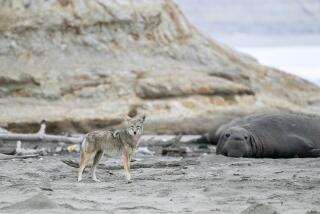Humane Society to Join Anti-Trap Effort
- Share via
SEAL BEACH — The Humane Society of the United States will attempt to intervene next week in a federal lawsuit to protect red foxes, skunks, cats and opossums that are being trapped at the Seal Beach National Wildlife Refuge on the Seal Beach Naval Weapons Station.
The Humane Society, the largest animal-protection organization in the world, will seek to join the Huntington Beach-based Animal Lovers Volunteer Assn. in its battle against the U.S. Navy and the U.S. Fish and Wildlife Service.
Dr. John Grandy, Humane Society vice president of wildlife and environment, said the two federal agencies have been trapping and killing red foxes in an effort to keep them from allegedly preying on two endangered bird species--the California least tern and the light-footed clapper rail. In the process, the traps catch not only foxes but also house cats, skunks and opossums, and they are presumably killed, he said.
“Part of our fear is that skunks and opossums may be eliminated in this process because they are easier to catch,” he said.
“There is no reason Fish and Wildlife has to use something as barbaric and painful as the steel-jaw trap in combination with T61, a poison that causes convulsions and excruciating death,” he said. “We suggest that if they are going to do this, that they do it in a manner that does not hurt the animals.”
A hearing on a motion to intervene is scheduled for Monday in federal court in Los Angeles, said attorney Marian Blakeslee, who represents both the Animal Lovers and the Humane Society. She said the Humane Society also will attempt to name the Department of Interior as a third defendant in the suit.
Navy public information officer Tom Thomas declined to comment Wednesday because the case is pending. Assistant U.S. Atty. Robert B. Briggs, who represents the federal agencies, did not return several calls for comment.
Authorities at the 1,100-acre National Wildlife Refuge have been trapping and killing red foxes for four years, Blakeslee said. In January, the total number of foxes trapped and killed had reportedly reached 275.
In 1986, the animal lovers association filed suit against the Navy and the wildlife service to stop the killings. Last year, a federal judge refused to grant an injunction against the trapping. But now, the animal lovers group is seeking to have the trapping stopped, at least until the agencies complete an environmental impact report.
Grandy said the trapping and killing of the foxes should stop simply because there is no direct proof that they are the reason for the declining numbers of least terns and the light-footed clapper rails.
“They don’t have evidence that foxes are killing the birds,” he said. “The least tern nesting area is already protected by an electrical fence. And there is no evidence that foxes have eaten the light-footed clapper rails.”
Grandy said Humane Society officials decided to intervene not only to stop the trapping but also to raise an allegation that chemical discharges in that area are causing the decline of the bird populations.
In a report last year, Grady said Navy officials have confirmed that substances such as aluminum, asbestos, copper, chromium, mercury, nickel and paint wastes have been dumped on the refuge from time to time.
Said Grandy: “They should focus on the man-made factors that are negatively affecting wildlife before they begin killing animals.”
More to Read
Sign up for Essential California
The most important California stories and recommendations in your inbox every morning.
You may occasionally receive promotional content from the Los Angeles Times.













